Complete Solutions to CONSOLIDATED EXERCISE of chapter CELL CYCLE AND CELL DIVISION of Class 9 book with complete answers and questions
| Class 9 | BIOLOGY |
| Chapter | CELL CYCLE AND CELL DIVISION |
| CENGAGE BIOLOGY | CONSOLIDATED EXERCISE |
| Number Of Questions | 62 |
| Academic Year | 2023-24 |
Prior to meiosis, DNA replication occurs, so each chromosome contains two sister chromatids that are identical to the original chromosome. Meiosis is divided into two nuclear divisions: meiosis I and meiosis II. Each of these nuclear divisions shares many aspects of mitosis and can be divided into the same phases: prophase, metaphase, anaphase, and telophase, however, between the two divisions, DNA replication does not occur. Through this process, one diploid cell will divide into four haploid cells. During meiosis I. the pairs of homologous chromosomes are separated from each other. During prophase I, the homologous chromosomes line up together. During this time, crossing over canoccur(theexchangeofDNA betweenhomologous chromosomes). Crossing-over increases the new allele combinations in the gametes. Without crossing-over, the offspring would always inherit all of the many alleles on one of the homologous chromosomes. (An allele is an alternative form of a gene which is located at a specific position on a specific chromosome.) Because of crossing-over, the alleles on the homologous chromosomes can be scrambled to pass on unique combinations of alleles on the chromosome. Also, during prophase I. the spindle forms and the chromosomes condense as they coil up tightly. The spindle has the same function as in mitosis.
Briefly describe the similarities between the meiosis and mitosis processes.
View SolutionPrior to meiosis, DNA replication occurs, so each chromosome contains two sister chromatids that are identical to the original chromosome. Meiosis is divided into two nuclear divisions: meiosis I and meiosis II. Each of these nuclear divisions shares many aspects of mitosis and can be divided into the same phases: prophase, metaphase, anaphase, and telophase, however, between the two divisions, DNA replication does not occur. Through this process, one diploid cell will divide into four haploid cells. During meiosis I. the pairs of homologous chromosomes are separated from each other. During prophase I, the homologous chromosomes line up together. During this time, crossing over canoccur(theexchangeofDNA betweenhomologous chromosomes). Crossing-over increases the new allele combinations in the gametes. Without crossing-over, the offspring would always inherit all of the many alleles on one of the homologous chromosomes. (An allele is an alternative form of a gene which is located at a specific position on a specific chromosome.) Because of crossing-over, the alleles on the homologous chromosomes can be scrambled to pass on unique combinations of alleles on the chromosome. Also, during prophase I. the spindle forms and the chromosomes condense as they coil up tightly. The spindle has the same function as in mitosis.
How many haploid cells will result from one diploid cell after it has undergone meiosis?
View SolutionPrior to meiosis, DNA replication occurs, so each chromosome contains two sister chromatids that are identical to the original chromosome. Meiosis is divided into two nuclear divisions: meiosis I and meiosis II. Each of these nuclear divisions shares many aspects of mitosis and can be divided into the same phases: prophase, metaphase, anaphase, and telophase, however, between the two divisions, DNA replication does not occur. Through this process, one diploid cell will divide into four haploid cells. During meiosis I. the pairs of homologous chromosomes are separated from each other. During prophase I, the homologous chromosomes line up together. During this time, crossing over canoccur(theexchangeofDNA betweenhomologous chromosomes). Crossing-over increases the new allele combinations in the gametes. Without crossing-over, the offspring would always inherit all of the many alleles on one of the homologous chromosomes. (An allele is an alternative form of a gene which is located at a specific position on a specific chromosome.) Because of crossing-over, the alleles on the homologous chromosomes can be scrambled to pass on unique combinations of alleles on the chromosome. Also, during prophase I. the spindle forms and the chromosomes condense as they coil up tightly. The spindle has the same function as in mitosis.
During prophase I, a unique process occurs. Provide the name and brief definition of this process.
View SolutionPrior to meiosis, DNA replication occurs, so each chromosome contains two sister chromatids that are identical to the original chromosome. Meiosis is divided into two nuclear divisions: meiosis I and meiosis II. Each of these nuclear divisions shares many aspects of mitosis and can be divided into the same phases: prophase, metaphase, anaphase, and telophase, however, between the two divisions, DNA replication does not occur. Through this process, one diploid cell will divide into four haploid cells. During meiosis I. the pairs of homologous chromosomes are separated from each other. During prophase I, the homologous chromosomes line up together. During this time, crossing over canoccur(theexchangeofDNA betweenhomologous chromosomes). Crossing-over increases the new allele combinations in the gametes. Without crossing-over, the offspring would always inherit all of the many alleles on one of the homologous chromosomes. (An allele is an alternative form of a gene which is located at a specific position on a specific chromosome.) Because of crossing-over, the alleles on the homologous chromosomes can be scrambled to pass on unique combinations of alleles on the chromosome. Also, during prophase I. the spindle forms and the chromosomes condense as they coil up tightly. The spindle has the same function as in mitosis.
What are the advantages of that process?
View SolutionA somatic cell of an animal has 18 chromosomes.
What is the diploid number of chromosomes for this animal?
View SolutionA somatic cell of an animal has 18 chromosomes.
How many chromosomes would be present in a haploid cell for this animal?
View SolutionA somatic cell of an animal has 18 chromosomes.
If a somatic cell of this animal is divided by mitosis, how many chromosomes would each daughter cell contain?
View SolutionThe diagrams below show cells in various phases of the cell cycle. Note the cells are not arranged in the order in which the cell cycle occurs. Use these diagrams to answer the following questions.
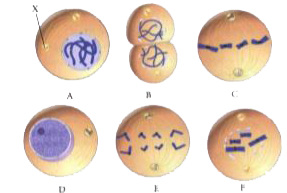
Which cell is in metaphase?
View SolutionThe diagrams below show cells in various phases of the cell cycle. Note the cells are not arranged in the order in which the cell cycle occurs. Use these diagrams to answer the following questions.
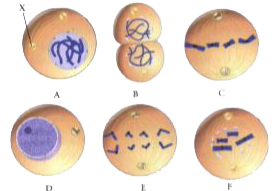
Which cell is in the first phase of M phase (mitosis)?
View SolutionThe diagrams below show cells in various phases of the cell cycle. Note the cells are not arranged in the order in which the cell cycle occurs. Use these diagrams to answer the following questions.
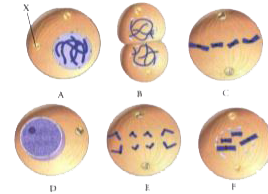
In cell A, what structure is labelled X?
View SolutionThe diagrams below show cells in various phases of the cell cycle. Note the cells are not arranged in the order in which the cell cycle occurs. Use these diagrams to answer the following questions.
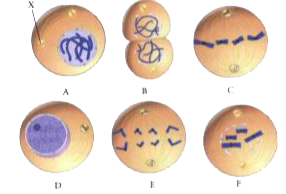
List the diagrams in order from first to last in the cell cycle.
View SolutionThe diagrams below show cells in various phases of the cell cycle. Note the cells are not arranged in the order in which the cell cycle occurs. Use these diagrams to answer the following questions.
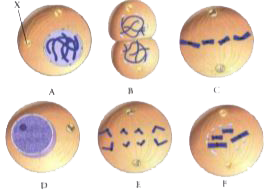
(i) Are the cells depicted plant or animal cells?
(ii) Explain your answer.
View SolutionThe diagrams below show cells in various phases of the cell cycle. Note the cells are not arranged in the order in which the cell cycle occurs. Use these diagrams to answer the following questions.
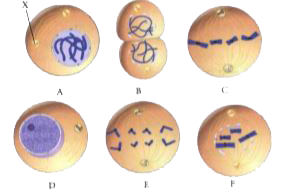
What is the longest phase of the cell cycle?
View SolutionEach characteristic or event given below applies to mitosis, meiosis, or both. Indicate the types of cell division in the lines provided.
One cell divides two times to form four cells `"________"`
Formation of gametes (egg and sperm) `"________"`
Zygote (fertilised egg) divides to form the trillion- celled baby `"________"`
Daughter cells have the identical chromosomes as the parent cell `"________"`
Pairing up and crossing-over between homologous chromosome pairs occurs at prophase. `"________"`
View SolutionLiver cells, bone cells, nerve cells, and muscle cells are called `"________"`
cells.
Sperm cells and egg cells are called `"________"`
View SolutionComplete the following table:
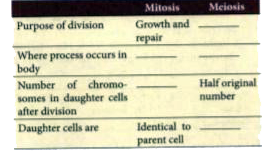
View SolutionMatch the names of scientists in column A with their discoveries in column B. (There could be more than one correct option.)
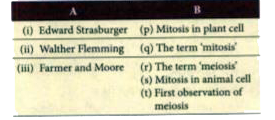
View SolutionMatch the phases of mitosis in column A with statements in column B. (There could be more than one correct answer.)

View Solution`"________"` is a disease that occurs when cells divide uncontrollably.
View SolutionFill in the blanks with appropriate answers from the box.
Summary of telophase
Telophase is the final phase of `"________"` and `"________"` During telophase the `"________"` envelope reforms and the `"________"` reappears within the nucleus. Chromosomes elongate and, once again, are described as `"________"` By the end of telophase, the cytoplasm from the original cell usually divides to form daughter cells by a process called `"________"`
View SolutionHistone protein synthesis occurs during
View SolutionCrossing over occurs during
View SolutionNuclear envelope reappears at
View SolutionTransfer of genes from one chromosome to another and vice-versa during synapsis is called
View SolutionThe sequence of cell cycle is
View SolutionNuclear envelope disappears at
View SolutionCytokinesis is
View SolutionPlant cells lack
View SolutionWhat is the proper sequence in mitosis ?
View SolutionChiasmata are first seen in
View SolutionIn mitosis ,centromere divides during
View SolutionColchicine arrest mitosis at
View SolutionMitosis can be studied in
View Solution`G_(1), S and G_(2)` are stages of
View SolutionChromosome number is restored by
View Solutionhomologous chromosomes seperates during
View SolutionDuring mitosis ER and nucleolus begin to disappear at
View SolutionCrossing over requires an anzyme
View SolutionIn mitosis, the number of chromosomes
View SolutionAt what stage does the number of chromosomes become half ?
View SolutionCell cycle was discovered by
View SolutionInvisible stage of M-phase is
View SolutionAmitosis was discovered by
View SolutionWhere can we study mitosis ?
View SolutionPlant and animal cell divisions differ in
View SolutionBouquet stage occurs during
View SolutionPhase of shortest duration is
View SolutionCrossing over takes place in
View SolutionWhich is the shortest phase in the cell cycle?
View SolutionWhich of the following serves as a mitotic spindle poison?
View SolutionDuring mitosis, metaphase differ from anaphase in having
View SolutionIn a chromosome, on the sides of centromere disc-shaped structure are present called
View SolutionDyad is a pair of
View SolutionReplication of centriole occurs during
View SolutionBest material for the study of mitosis is
View SolutionHow many chromosomes will the cell have at `G_1` after S and after Mitotic phase respectively?
View SolutionIn which stage of mitosis chromosomes arrange on equatorial plate?
View SolutionWhat are the major features of prophase in mitosis?
View SolutionSexual reproduction requires which of the following?
View SolutionThere is DNA replication during the stages of
View SolutionSister chromatids move apart in which of the following stages?
View SolutionWhich of the following distinguishes prophase I of meiosis I from mitotic prophase?
View Solution
CONSOLIDATED EXERCISE questions and complete solutions for chapter CELL CYCLE AND CELL DIVISION of CENGAGE BIOLOGY of Class 9